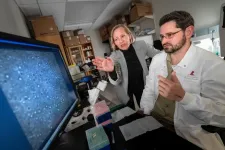(Press-News.org) OKLAHOMA CITY, OKLA. – A study published today by a University of Oklahoma researcher shows that financial incentives can make a big difference in helping smokers quit. The study found that when people with low socioeconomic staus are offered small financial incentives to stop smoking (in addition to receiving counseling and pharmacotherapy, primarily nicotine replacement therapy), they achieve higher quit rates, with some measures doubling the quit rates, when compared to study participants who received the same treatments without incentives. This finding is particularly important because adults with socioeconomic challanges are more likely to smoke, experience more difficulty quitting, and suffer from more tobacco-related health problems and deaths than the general population.
The study, published in JAMA Network Open, a journal of the American Medical Association, was led by Darla Kendzor, Ph.D., co-director of the TSET Health Promotion Center at OU Health Stephenson Cancer Center and a professor of family medicine in the OU College of Medicine.
“It’s an amazing finding that smoking quit rates were doubled at final follow-up simply by offering small incentive payments for quitting,” Kendzor said. “This is especially important for the counties in Oklahoma that have high levels of poverty and where many people don’t have health insurance and face other socioeconomic challenges. Smoking rates are as high as 30% in some Oklahoma counties, which is much higher than national estimates.”
The study’s findings come from a clinical trial in which adults were randomly assigned to one of two groups: those who received pharmacotherapy and counseling with a tobacco treatment specialist, and those who received the same treatments in addition to financial incentives for smoking abstinence.
Participants could earn up to $150 through weekly incentives if they were not smoking during the first several weeks after a quit attempt. The incentives started at $20 and increased by $5 each week, and there were additional $50 booster payments for smoking cessation at eight- and 12-week follow-ups. To verify that they had quit smoking, participants were required to blow into a carbon monoxide monitor. Twenty-six weeks after the start of the trial, an estimated 23.5% of participants receiving financial incentives were smoke-free, compared to 12.1% of those who did not receive incentives.
“People may be motivated to quit smoking because of the financial incentive, which can also increase their motivation to complete their counseling sessions and take their medication as directed,” she said. “Incentivizing early success can potentially increase people’s self-efficacy for quitting. People may be ambivalent about quitting smoking, or they may not be sure they will be able to quit. But when there’s an incentive on the line and people have some initial success, that success can build from week to week. Incentives can also help people get back on track. When people lapse and restart smoking, they might be more likely to try to quit again because an incentive is available the next week.”
Although the clinical trial began in 2017 before the arrival of COVID-19, it continued until 2022, two years into the pandemic. Study results reflect the upheaval caused by the pandemic: People in the incentivized group who participated in the trial before COVID-19 arrived had much higher cessation rates than those in the same group whose participation began after COVID-19.
“It was much harder for people to quit smoking during the worst time of the pandemic, and we had more attrition during that time as well,” Kendzor said. “If this study had finished before COVID-19, we might have had even higher rates of cessation.”
Efforts are underway to translate the study’s findings to cessation strategies available to the public at large. Kendzor is collaborating with the Oklahoma Tobacco Settlement Endowment Trust (TSET), which funds the Oklahoma Tobacco Helpline (1-800-QUIT NOW), to evaluate and implement financial incentives for people calling the helpline. TSET is the state grantmaking trust established by voters in 1998 with payments from the Master Settlement Agreement with tobacco companies. In 2000, Oklahoma became the first state where residents voted to constitutionally protect the funds for the prevention of cancer and cardiovascular disease.
Kendzor is also enrolling participants in a new study to compare the same treatments with and without financial incentives, but, this time, delivered through a smartphone app. Participants will complete counseling by phone and receive nicotine replacement therapy in the mail. A portable carbon monoxide monitoring device will be connected to their phones to verify smoking cessation, and facial recognition will confirm their identity. Incentives will be added to participants’ credit cards.
“In our newly published study, we worked with Oklahomans who could come into the clinic, but that is a huge barrier for some people,” she said. “We can reach a much broader range of people in the new study that uses smartphone-delivered treatment. Because the majority of people have smartphones, we believe that approach, combined with incentives, can bypass some of the obstacles that people face and help them reach their goals of tobacco cessation.”
###
About the project
The study, “Financial Incentives for Smoking Cessation Among Socioeconomically Disadvantaged Adults: A Randomized Clinical Trial,” can be found online here.The research was supported primarily by a grant from the National Institutes of Health, with additional support from TSET and OU Health Stephenson Cancer Center. TSET also supports the Health Promotion Research Center that Kendzor co-directs.
About the University of Oklahoma
Founded in 1890, the University of Oklahoma is a public research university located in Norman, Oklahoma. As the state’s flagship university, OU serves the educational, cultural, economic and health care needs of the state, region and nation. OU was named the state’s highest-ranking university in U.S. News & World Report’s most recent Best Colleges list. For more information about the university, visit www.ou.edu.
END
(MEMPHIS, Tenn. – July 2, 2024) Biomolecular condensates are membraneless hubs of condensed proteins and nucleic acids within cells, which researchers are realizing are tied to an increasing number of cellular processes and diseases. Studies of biomolecular condensate formation have uncovered layers of complexity, including their ability to behave like a viscoelastic material. However, the molecular basis for this putty-like property was unknown. Through a multi-institution collaboration, St. Jude Children’s Research Hospital scientists examined the interaction networks within condensates ...
MSU has a satellite uplink/LTN TV studio and Comrex line for radio interviews upon request.
EAST LANSING, Mich. – Randomized controlled trials, or RCTs, are believed to be the best way to study the safety and efficacy of new treatments in clinical research. However, a recent study from Michigan State University found that people of color and white women are significantly underrepresented in RCTs due to systematic biases.
The study, published in the Journal of Ethnicity in Substance Abuse, reviewed 18 RCTs conducted over the last 15 years that tested treatments for post-traumatic stress and alcohol use disorder. The researchers ...
Key takeaways
Raising the energy state of an atom’s nucleus using a laser, or exciting it, would enable development of the most accurate atomic clocks ever to exist. This has been hard to do because electrons, which surround the nucleus, react easily with light, increasing the amount of light needed to reach the nucleus.
By causing the electrons to bond with fluorine in a transparent crystal, UCLA physicists have finally succeeded in exciting the neutrons in a thorium atom’s nucleus using a moderate amount of laser light.
This accomplishment means that measurements of time, gravity and other fields that are currently performed ...
EDMONTON — A new groundbreaking study sheds light on a medical question scientists have long wondered: why do 40 per cent of children with the rare neurodevelopmental disorder KBG syndrome have heart defects? The research now points to a critical link between the heart and the brain.
KBG syndrome can cause unusual facial development, skeletal abnormalities, intellectual underdevelopment and heart defects. The syndrome is caused by mutations in the ANKRD11 gene, which plays a crucial role in brain development, but it wasn’t until now ...
A research effort led by scientists at the U.S. Department of Energy’s (DOE’s) National Renewable Energy Laboratory (NREL) has made advances that could enable a broader range of currently unimagined optoelectronic devices.
The researchers, whose previous innovation included incorporating a perovskite layer that allowed the creation of a new type of polarized light-emitting diode (LED) that emits spin-controlled photons at room temperature without the use of magnetic fields or ferromagnetic contacts, now have gone a step further by integrating a III-V semiconductor ...
A colder nose and warmer cheeks may be a telltale sign of rising blood pressure.
Researchers discovered that temperatures in different face regions are associated with various chronic illnesses, such as diabetes and high blood pressure. These temperature differences are not easily perceptible by one’s own touch but can instead be identified using specific AI-derived spatial temperature patterns that require a thermal camera and a data-trained model. The results appear July 2 in the journal Cell Metabolism. With ...
Researchers show for the first time that engineered human plasma B cells can be used to treat a disease—specifically leukemia—in a humanized animal model. The results mark a key step in the realization of ePCs as therapies to treat cancer, auto-immune disorders, and protein deficiency disorders. The results appear July 2 in the journal Molecular Therapy.
“We hope that this proof-of-concept study is the first of many applications of engineered plasma B cells, and eventually will lead to a single-shot therapeutic,” says senior study author Richard James (@ScienceRicker) of the Seattle Children’s ...
When it comes to managing blood sugar levels, most people think about counting carbs. But new research from the University of British Columbia shows that, for some, it may be just as important to consider the proteins and fats in their diet.
The study, published today in Cell Metabolism, is the first large-scale comparison of how different people produce insulin in response to each of the three macronutrients: carbohydrates (glucose), proteins (amino acids) and fats (fatty acids).
The findings reveal that production of the blood sugar-regulating hormone insulin is much more dynamic and individualized than previously ...
Melting of glaciers in a major Alaskan icefield has accelerated and could reach an irreversible tipping point earlier than previously thought, new research suggests.
The research, led by scientists at Newcastle University, UK, found that glacier loss on Juneau Icefield, which straddles the boundary between Alaska and British Columbia, Canada, has increased dramatically since 2010.
The team, which also included universities in the UK, USA and Europe, looked at records going back to 1770 and identified three distinct periods in how icefield volume changed. They saw that glacier volume loss remained fairly ...
Scientists have identified a gene which, when missing or impaired, can cause obesity, behavioural problems and, in mothers, postnatal depression. The discovery, reported today in Cell, may have wider implications for the treatment of postnatal depression, with a study in mice suggesting that oxytocin may alleviate symptoms.
Obesity and postnatal depression are significant global health problems. Postnatal depression affects more than one in 10 women within a year of giving birth and is linked to an increased risk of ...



